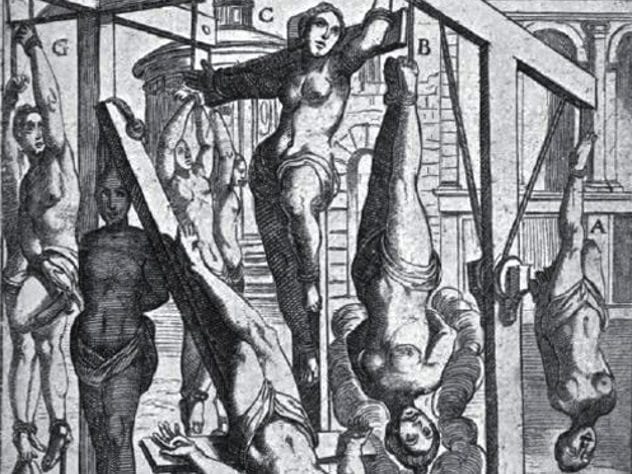 Humans
Humans  Humans
Humans  Gaming
Gaming 10 Overused Game Villains
 Mysteries
Mysteries Ten Mysterious “Ghost Ship” Stories That Still Keep Us Wondering
 Technology
Technology 10 Times AI Replaced Humans (and No One Noticed)
 Politics
Politics 10 Dreaded Despots Who Met Untimely Deaths
 Pop Culture
Pop Culture 10 Celebs Who Have Surprisingly Wanted to Be on Reality TV
 Creepy
Creepy 10 of the Strangest Popular Creepypastas
 Animals
Animals 10 Animals That Used to Be Bigger
 Our World
Our World 10 American Cities, Towns & Villages That Are Unlike Any Other
 Movies and TV
Movies and TV 10 Huge Movies Almost Made by Other Directors
 Humans
Humans 10 Real Life Versions of Famous Superheroes
 Gaming
Gaming 10 Overused Game Villains
 Mysteries
Mysteries Ten Mysterious “Ghost Ship” Stories That Still Keep Us Wondering
Who's Behind Listverse?

Jamie Frater
Head Editor
Jamie founded Listverse due to an insatiable desire to share fascinating, obscure, and bizarre facts. He has been a guest speaker on numerous national radio and television stations and is a five time published author.
More About Us Technology
Technology 10 Times AI Replaced Humans (and No One Noticed)
 Politics
Politics 10 Dreaded Despots Who Met Untimely Deaths
 Pop Culture
Pop Culture 10 Celebs Who Have Surprisingly Wanted to Be on Reality TV
 Creepy
Creepy 10 of the Strangest Popular Creepypastas
 Animals
Animals 10 Animals That Used to Be Bigger
 Our World
Our World 10 American Cities, Towns & Villages That Are Unlike Any Other
 Movies and TV
Movies and TV 10 Huge Movies Almost Made by Other Directors
10 Horrifying Tortures Used in Ancient Rome
In ancient Rome, the general rule was that slaves could be freely tortured. In fact, it was highly recommended that any free man accused of a crime would have his slaves tortured in his place, often to the death, so that a verdict could be reached. That didn’t stop Rome’s elite from torturing the free men and women of their country, though. There were always loopholes in the laws of ancient Rome, and the elite rulers exploited each and every one of them.
10 Sewn Into a Donkey

If you’re looking for cruel and unusual forms of torture, you don’t have to look any further than ancient Rome. Take, for instance, a torture that was described by both Apuleius (The Golden Ass) and Lucian (Lucius, or the Ass):
A donkey would be killed, its belly sliced open, and the entrails removed. The accused was then stripped of clothing and stuffed into the animal’s belly. The belly was stitched closed, leaving only the accused’s head outside, preventing suffocation but prolonging suffering.
The donkey’s body was kept in the sun. It would begin to decompose—with the living victim inside being cooked by the heat. Maggots would crawl all over the accused, and vultures would peck at the animal’s decaying flesh. Death, while welcomed, came slowly for the victim of this torture.
9 Fed to Wild Hogs

Saint Gregory described a heinous torture that was performed on young women by the people of Heliopolis while under Roman rule:
Any virgin who was to undergo this torture was first given to the gladiators. After the young woman was no longer a virgin, she was publicly stripped, and her belly was sliced open, spilling her innards out. Handfuls of barley were stuffed into her, and she was sewn back up—only to be given to wild hogs. She would then be torn apart.
8 Cut Off

In ancient Rome, the higher your status, the more people you were allowed to bone without consequence. For example, the emperor would get it on with anyone he wanted. A general could make a move on a lieutenant or a common citizen, and soldiers could go after common citizens.
Climbing up the social ladder was forbidden. If a common citizen decided to penetrate an unwilling soldier, the punishment was public castration. If the soldier willingly allowed the common citizen to penetrate him, he would be publicly disemboweled.
These rules, coupled with true love between men, really muddied up the waters. It was easy for anyone to accuse a man of breaking rank or willingly giving in to penetration by a man of lesser status.
7 Poena Culle

The Romans also ushered in the use of the poena cullei, meaning Penalty of the Sack. The criminal was sewn up in a basic leather sack—and drowned, with death being the ultimate goal. The general consensus is poena cullei first appeared in Titus Livy’s History of Rome. In it, Livy describes how Marcus Publicius Malleolus was sewn into a sack and thrown out to sea in 101 BC for killing his mother. Livy’s version of events appears tame compared to later versions of the punishment, which included the use of live animals.
According to Emperor Justinian’s laws from AD 530: “This is not execution by the sword or by fire, or any ordinary form of punishment, but the criminal is sewn up in a sack with a dog, a cock, a viper, and an ape, and in this dismal prison is thrown into the sea or a river…” Luckily, the ancient Romans reserved this rarely given punishment for parricide—killing a parent or other close relative.
6 Tortured Senator

Emperor Caligula was just as cruel as old Tiberius. At one point, he had a senator slit open. The senator survived, and Caligula ordered that his eyes be removed. After that, hot pincers were used to take out his internal organs. To add to the degradation, the senator was cut in half and torn to pieces.
According to Roman belief, death was not a punishment, but a release. The torture was punishment, and death was only allowed after a certain amount of pain and terror had been felt.
5 Nailed Into Barrels

Some people were meant to suffer longer than others before the sweet release of death. Under Emperor Domitian, Christians were tortured in the most horrific ways.
One of the most disgusting tortures performed involved smearing a Christian in honey and milk. The victim was then nailed into a barrel and force-fed parasite-ridden food. The parasites feasted on the insides the of victim, whose body began to rot inside the barrel. After about two weeks of this torture, the victim would finally die and become a martyr for the Christian religion.
4 Buried Alive

Emperor Nero took delight in having people buried alive. He almost exclusively saved this punishment for vestal virgins who broke their vows of chastity. In one account, Nero forced himself on the priestess Rubria. For her punishment, she was entombed inside a small cave and left to starve to death.
Another torture supported by Nero involved the accused digging his own grave. After it was dug, a stake was set inside the grave. The accused was then bound and pushed into the grave. If his crime were minor, he would be pushed so that the stake pierced through his heart. Anyone convicted of a heinous crime was pushed so that the stake mortally wounded him. He was then left to die in excruciating pain or was buried alive.
3 Eaten Through the Middle

Executioners often used animals to carry out their barbarity, as was the case with the cauldron torture. For this particular cruelty, a starved animal, such as a rat, a dog, or a cat, was placed inside a small cauldron. The opening of the cauldron was then fastened to the belly of the accused.
The executioner would hold a flame to the back of the cauldron, making the inside extremely hot. The animal would panic and try to escape. The only soft “ground” for it to dig its way out was through the belly of the accused.
2 Bee Basket

One bizarre form of torture involved stripping a person down and stuffing him into a large, loosely woven basket. The basket was then hoisted up into a tree containing a large, active beehive. The bees were quickly angered, and the person inside the basket was then stung to death.
The accused was meant to suffer in agony for as long as possible. However, there were cases where the victim of this torture died relatively quickly due to being allergic to bee stings.
1 Crucifixion

Ancient Romans loved a good crucifixion. It was at one time the primary method used to tortured and kill countless numbers of slaves.
Crucifixion didn’t always involve nailing the accused to a cross. Sometimes, the accused was stripped, his head was covered, and he was tied down onto a cross or fork. He was then flogged, sometimes until he died.
If the accused was not supposed to die by continuous flogging, the next course of action involved nailing his hands to the cross beam. He was then hoisted onto a planted post, and his feet were nailed to the post. He might be left there to die a slow death, or his thighs might be broken to help speed his end.
In some cases, the accused might be hung upside down on the post. Other times, the executioner had the post driven through the accused’s private parts. The methods used differed from executioner to executioner, with no one set method of crucifixion for all.
Elizabeth spends most of her time surrounded by dusty, smelly, old books in a room she refers to as her personal nirvana. She’s been writing about strange “stuff” since 1997 and enjoys traveling to historical places.








